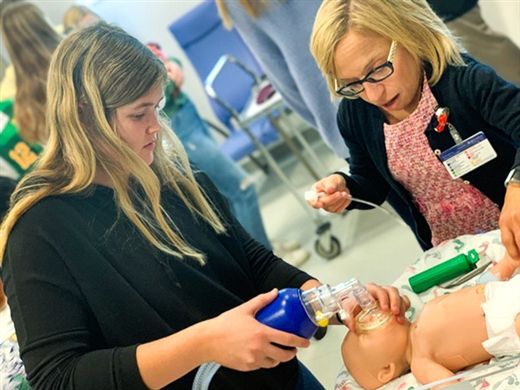

Students Tour Center for Medical Simulation and Innovative Education
Source/Author: Raffi Darrow, Ebytes Editor
January 10, 2020
Shorecrest Upper School students in Lisa Peck's Intro to Medical Sciences course received an enthralling tour of the Center for Medical Simulation and Innovative Education at Johns Hopkins All Children's Hospital.
A simulation center is a testing, research and training facility that mimics clinical spaces such as the clinic, patient care room, intensive care unit and the operating room as well as non-clinical spaces such as a child’s room at home or classroom. There, clinicians train to provide patients with reliable, specialized, and complex medical care.
Medical Director and Neonatologist, Dr. Jen Arnold, led the students through a tour of the facility - pausing repeatedly for a variety of learning experiences.
"Crises during surgery are rare, but they are high risk, so doctors need to be able to act quickly to make critical decisions." Dr. Arnold said when explaining the need for a Sim Center. Hospitals hope to make treatment safer and shorter for patients through the use of simulation training. She explained that CPR is a common procedure practiced there, and often has the greatest value. She also said that emergencies during surgery that often lead to the worse outcomes are not due to a lack of knowledge, but rather a breakdown in teamwork. Simulations allow for educator and technological feedback and debriefing, in part because trainings are video-recorded and then reviewed by learners.
Shorecrest students helped treat robotic children and infant mannequins with chest compressions, ventilation, defibrillation, intubation. Some mannequins at the Sim Center are sophisticated enough to speak pre-programmed phrases, simulate the birthing process, and allow clinicians to practice drawing blood.
At the close of the tour, an engineer on the JHACH team presented medical-grade, 3D printed organs to the teens.
On the bus ride back to school, students reviewed their favorite parts of the tour and what they learned. The realism of the simulations shocked them, especially the 3D printed premature infant (with hair!) modeled after a real patient of the Hospital.
View more photos and video clips from the field experience here.
A simulation center is a testing, research and training facility that mimics clinical spaces such as the clinic, patient care room, intensive care unit and the operating room as well as non-clinical spaces such as a child’s room at home or classroom. There, clinicians train to provide patients with reliable, specialized, and complex medical care.
Medical Director and Neonatologist, Dr. Jen Arnold, led the students through a tour of the facility - pausing repeatedly for a variety of learning experiences.
"Crises during surgery are rare, but they are high risk, so doctors need to be able to act quickly to make critical decisions." Dr. Arnold said when explaining the need for a Sim Center. Hospitals hope to make treatment safer and shorter for patients through the use of simulation training. She explained that CPR is a common procedure practiced there, and often has the greatest value. She also said that emergencies during surgery that often lead to the worse outcomes are not due to a lack of knowledge, but rather a breakdown in teamwork. Simulations allow for educator and technological feedback and debriefing, in part because trainings are video-recorded and then reviewed by learners.
Shorecrest students helped treat robotic children and infant mannequins with chest compressions, ventilation, defibrillation, intubation. Some mannequins at the Sim Center are sophisticated enough to speak pre-programmed phrases, simulate the birthing process, and allow clinicians to practice drawing blood.
At the close of the tour, an engineer on the JHACH team presented medical-grade, 3D printed organs to the teens.
On the bus ride back to school, students reviewed their favorite parts of the tour and what they learned. The realism of the simulations shocked them, especially the 3D printed premature infant (with hair!) modeled after a real patient of the Hospital.
View more photos and video clips from the field experience here.
























